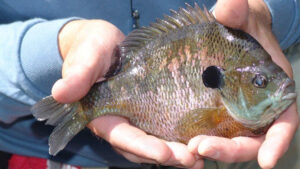Warning: Undefined variable $k in /home/nginx/domains/wired2fishcom.bigscoots-staging.com/public/wp-content/themes/understrap-child-0.6.0/functions.php on line 984
Warning: Undefined variable $k in /home/nginx/domains/wired2fishcom.bigscoots-staging.com/public/wp-content/themes/understrap-child-0.6.0/functions.php on line 987
I’ve caught a lot of bluegill on a lot of different baits. I’ve used everything from wiggler worms and crickets to shallow running crankbaits and tiny gold-plated jigs dropped through a hole in the ice.
Without question, my favorite bluegill bait – at least in warm latitudes – is dough balls.
But not just any dough balls. No, my best bream bait is something I came up with in my youth. A simple fix to a frustrating problem; a stroke of near brilliance that yielded a straight-up game-changing, fish-catching formula that I still use to this day.
Join me, if you will, for a stroll down memory lane and I promise we’ll make a stop at Preparation Parkway, swing by Delivery Drive and end up at Bent Rod Boulevard.
THE BACK STORY
One warm summer morning, somewhere amid the daily Tom Sawyer-meets-Indiana Jones adventures of my youth, I spotted a bunch of bluegill darting in and out of the shadows of a floating dock. Ill-equipped, yet ever game for a challenge, I dashed home to fetch my trusty Zebco 202 and the humble bag of loose hooks and split shots comprising my first tackle box.
Unfortunately, the day’s economic reality threatened my enthusiasm. Monthly allowance day was still a week out and with several neighbors saving for vacation; my lawn-mowing business was experiencing a downturn.
My usual option of rounding up a dozen or so soft drink bottles and collecting the dime deposits would’ve burned valuable fishing time and that just didn’t sit well.
No way around it – I had no bait money and this was a long time before those crankbaits and gold-plated jigs would enter the picture.
Undaunted, I recalled an option – bread balls. Pinching a dime-sized piece of white bread, rolling it into a sphere and dropping it in front of a bluegill is an easy sell. However, mom advised me that the few slices remaining in the bag were reserved for dinner, pending her weekend grocery run.
Okay, we’ll go with Plan B – the homemade dough bait my uncle had shown me about a year earlier. With half a cup of flour, a little tap water and some diligent spoon action, I proudly whipped up a palm-sized portion of bluegill bait.
Eager to wet a line, I wrapped my fresh dough in a plastic sandwich bag, stuffed the bait into my Darth Vader t-shirt pocket, balanced my 202 on the handlebars of a green and black Huffy dirt bike and raced back to the bluegill dock.
Good news – the fish loved the soft, gooey dough. Bad news – too often, the soft bait fell to their larcenous way and left me reeling up a bare hook.
Disappointed, but not dissuaded, I returned to the kitchen and tinkered around until I came up with something that forever changed my panfish pursuits.
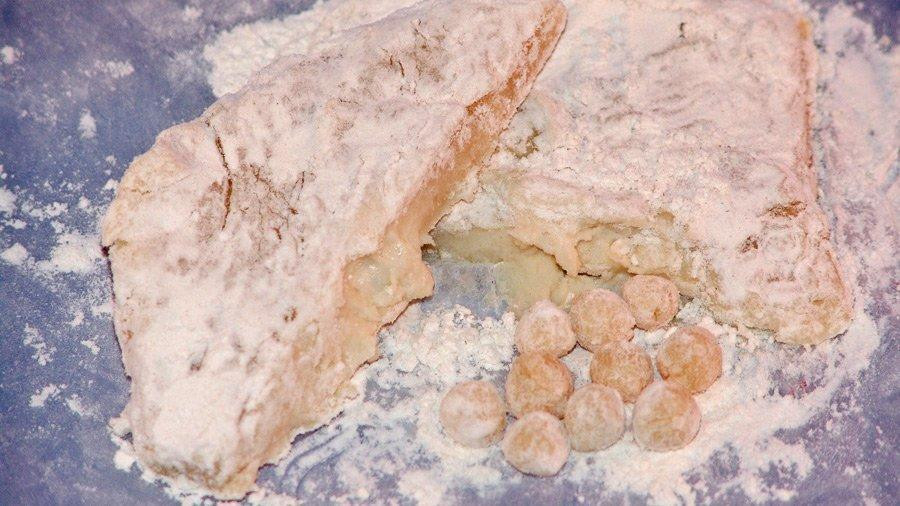
NEW AND IMPROVED
Like store bought bread, raw dough loosens when submerged. Hence, undersized fish and cautious keepers can pick you clean.
I pondered the premise and in a light bulb moment of inspiration, I tried cooking the dough in a microwave. Much to my delight, I found that a brief zapping congealed the mixture into a resilient consistency that I knew would beat the fish at their own game.
Here’s the basic formula: Mix half a cup of flour with just enough water to form a lumpy ball. Dust the outside of the dough with excess flour, flatten the dough into a patty ½-inch thick, place it on a doubled square of waxed paper and microwave on medium power for 30 seconds. To test the results, pinch the edge of the dough after nuking and roll it around on your fingertips. If the bait smears or sticks, cook it another 10-15 seconds.
Not only is microwaving quicker; it cooks without turning the dough dry and crusty. The resulting flakiness of baked dough bait mirrors the water-wear limitations of store-bought bread – both fall apart too easily.
Ideally, the finished product will have a rubbery texture that molds firmly and tightly cling to a hook. This forces fish to grab both bait and hook without pecking the dough off the barb. This bait is so tough you can often catch more than one fish on the same piece. Just remold it on the hook after each catch and drop it again.
White or wheat flour works equally well, but for optimal firmness with minimal air pockets, use all-purpose, not the self-rising flour. For enhanced scent appeal, add a little vanilla extract, onion powder or anise oil to your dough before baking.
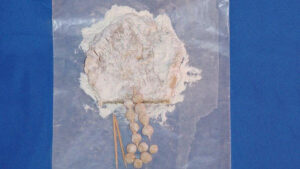
USER-FRIENDLY
Dough balls are a natural match for cane poles and 4- to 6-pound monofilament rigged with a small, round bobber, a No. 12 wire hook and just enough weight to maintain a vertical drop. Cane poles offer superior reach for probing around vegetation, but it’s tough to make a 12-foot twig cooperate when you’re trying to reach into the shadows of overhanging brush or under a dock. A light spinning or spincast outfit is a better choice for tight quarters.
Despite the microwave’s inherent jelling effect, a tight dough ball is paramount. Best bet is the stout diamond-shaped configuration created by simultaneously squeezing the bait between the thumb and forefinger of both hands. Squeeze the bait high and then low to form matching hemispheres. This affords two narrow hook entries that blend into an ample midsection for hiding a hook point. When you come tight on a taker, the barb will slide through the dough and into the fish’s mouth.
Maximize your fishing time by premaking several dough balls and skewering them on toothpicks. Think of it as dough ball speed loaders – you’ll capitalize on the action, especially with multiple rods, by leveraging an easily accessible supply of ammunition.
When your bait outlasts the action, the dough’s recyclable potential complements its low-cost advantage. Keep your leftover dough bait wrapped tightly and refrigerated after you’re finished fishing. When you’re ready to use it again, just add a few drops of water and zap it for 10 seconds or until the bait softens enough to mold it on a hook.
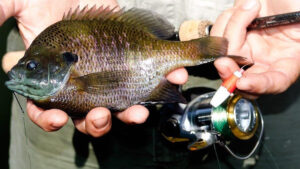
APPETIZER AWARENESS
If you’ve ever thrown stale bread into a lake with bluegill, you know the rolling, splashing, popping response. Well, chumming with dough bait is not different.
Dropping a few freebies into the target zone will A) help you locate bluegill, and B) concentrate the fish for easy pickings. As with any chumming, make sure you don’t quell the fish’s appetite by over feeding them.
Toss half a dozen dough bits into the target area and see if they disappear in a swift shadow. In low-visibility spots, work the surface by flattening your chum bits so they float on top or sink slowly. (Toss a few sinking bits first to grab your quarry’s attention.)
If the fish take a few seconds to hit the chum bits, they’re either spooky or sitting deep. In either case a high bobber or no bobber is the way to go. Conversely, if the fish bust the freebies immediately, you can plan on staying busy for as long as you can stand it.
Once the fish start boiling on chum bits, toss a few more freebies and then sneak your baited hook amid the chum. Likewise, if your bait sits untouched too long, drop a few chum bits next to the hook. The sudden concentration of food often convinces skeptical fish and stimulates a rally.
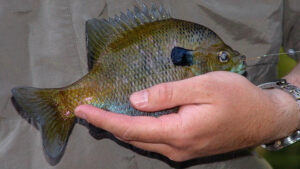
STUFF THAT MATTERS
Now, if you’re wondering if this reminiscent rambling has a point, it does – actually two. First, even the best solutions can always stand a little tweaking. Particularly with fishing, the impediments to any objective can either frustrate us or inspire us.
I’m sticking with No. 2.
Secondly, regardless of how elaborately advanced our adult angling acumen becomes, most of us began our fishing careers tugging on something small and sporty – something like a bluegill. So, the real story here is not so much the adolescent adventures of a long-winded storyteller; rather, it’s about developing a homemade bait formula that provides a simple and convenient option for the light duty fishing that should never fade into distant memories.
So whether you’re hosting kids or enjoying a relaxed solo mission, there’s a pleasantly old-school vibe about homemade dough balls and bluegill. It’s something endearingly rustic, in a Tom Sawyer kind of way.
Heck, we’ll even invite Indiana Jones.
